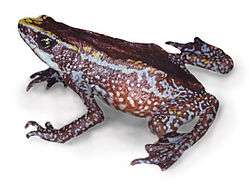Atelopus chiriquiensis
| Atelopus chiriquiensis | |
|---|---|
 | |
| Scientific classification | |
| Kingdom: | Animalia |
| Phylum: | Chordata |
| Class: | Amphibia |
| Order: | Anura |
| Family: | Bufonidae |
| Genus: | Atelopus |
| Species: | A. chiriquiensis |
| Binomial name | |
| Atelopus chiriquiensis Shreve, 1936 | |
Atelopus chiriquiensis, the Chiriqui harlequin frog[2] or Lewis' stubfoot toad, is a species of toad in the family Bufonidae found in the Cordillera de Talamanca in Costa Rica and western Panama (Province and Bocas del Toro Provinces).[1][3] Its natural habitats are stream margins in lower montane wet forests and rainforests. Its elevational range is 1,400–2,500 m (4,600–8,200 ft) asl.[1]
Description
Atelopus chiriquiensis is a moderately sized toad: males measure 28–34 mm (1.1–1.3 in) in snout–vent length and females 36–49 mm (1.4–1.9 in). Colouring is highly variable and usually different between males and females. They have weakly developed and relatively inconspicuous poison glands scattered over the head and dorsum; nevertheless, they produce tetrodotoxin, a potent neurotoxin.[2]
Conservation status
This once locally abundant species has not been seen in Costa Rica after 1996 and is considered extinct the country. It may also have disappeared from Panama as there are no records since late 1990s. The decline is probably linked to chytridiomycosis. Habitat loss and introduced trout are also threats.[1]
References
- 1 2 3 4 Lips, K.; Ibáñez, R.; Bolaños, F.; Chaves, G.; Solís, F.; Savage, J.; Jaramillo, C.; Fuenmayor, Q. & Castillo, A. (2010). "Atelopus chiriquiensis". IUCN Red List of Threatened Species. Version 2014.3. International Union for Conservation of Nature. Retrieved 24 November 2014.
- 1 2 "Atelopus chiriquiensis". AmphibiaWeb: Information on amphibian biology and conservation. [web application]. Berkeley, California: AmphibiaWeb. 2014. Retrieved 24 November 2014.
- ↑ Frost, Darrel R. (2014). "Atelopus chiriquiensis Shreve, 1936". Amphibian Species of the World: an Online Reference. Version 6.0. American Museum of Natural History. Retrieved 24 November 2014.
